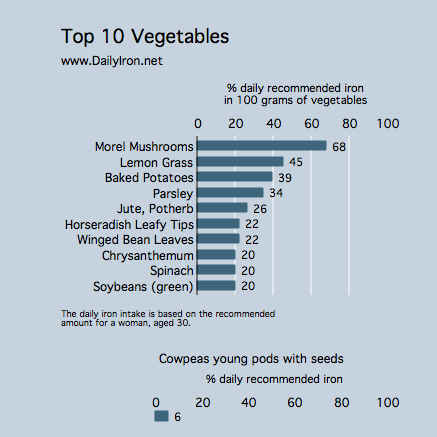Young cowpea pods contain 1 milligrams of iron per 100 grams. Grams is a measure of weight. To put 100 grams in perspective, consider alternative measures for this food:
- 1 cup equals 94 grams.
- 1 pod equals 12 grams.
In the category of vegetables, we included whole vegetable products in the Top 10 list. We excluded dried/dehydrated products from the Top 10. You will find some dehydrated vegetables high in iron per 100 grambut they tend to be far more volume than anyone would consume. Furthermore, foods may be fortified with iron but are not included in this Top 10 list. The food tested for the particular graph below can be described more specifically as:
Cowpeas, young pods with seeds, raw
Read more about iron in vegetables or visit our iron-rich foods list.

Vegetables in the main are not a good iron source. Those vegetables that are loaded with iron also are likely to be packed with iron inhibitors — you may not take in much of the iron from the vegetable itself.
Yet, even a vegetable with small amounts of iron may play an important role in iron absorption. Vegetables often times are rich in vitamin C, a vitamin that can assist you in using the iron better in vegetarian foods; cowpeas young pods are a great source of vitamin C.
For instance, you can incorporate peppers and tomatoes with a whole grain salad or with a bean recipe to increase your absorption of the iron in your meal as a whole. A raw papaya dessert with a meal would also increase your iron metabolism because of the fruit’s vitamin C content. A glass of fruit juice is also a good move.